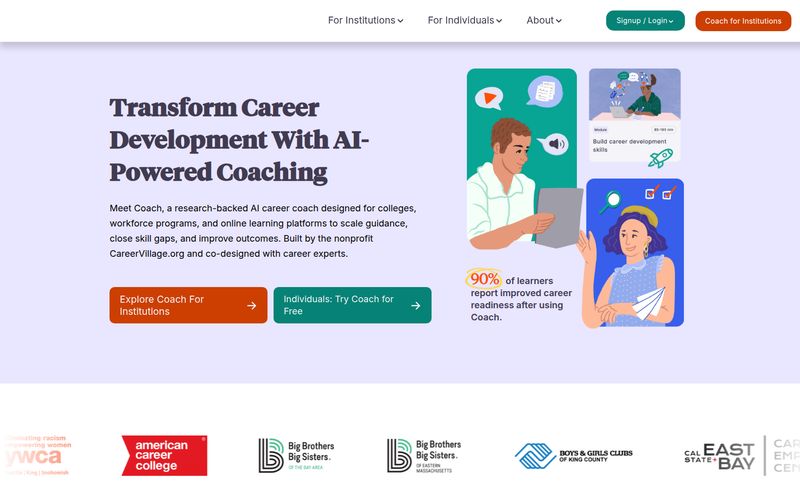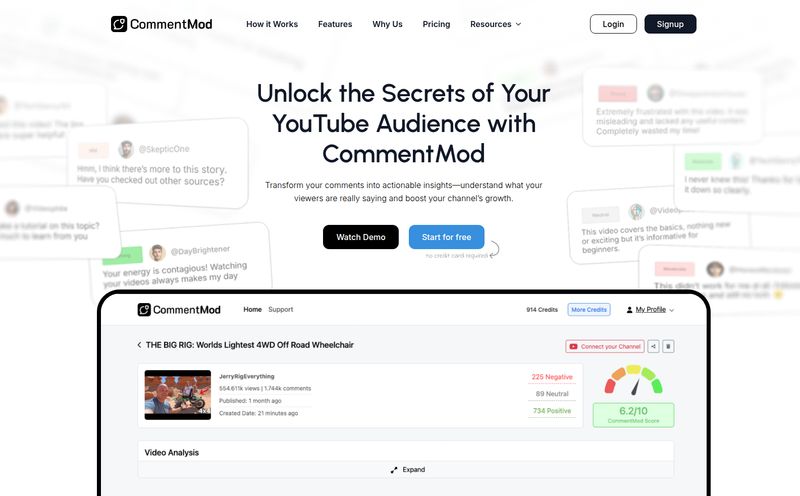The AI gold rush is on, and we're all scrambling to stake a claim. For the last couple of years, the name on everyone's lips has been OpenAI. And for good reason! They made large language models accessible, and suddenly every business, from a two-person startup to a multinational giant, was trying to bake some GPT magic into their products. But as the dust settles, a collective hangover is setting in. We're starting to ask the hard questions. Where is our data really going? Are we just training a model that our competitors can also use? Are we getting locked into a single vendor's ecosystem, praying they don’t change the rules or hike prices overnight?
I've had more than a few conversations over virtual coffee with fellow SEOs and developers who are feeling this exact pain. They love the power, but they're getting squeamish about the privacy implications and the one-size-fits-all nature of these massive, public models. It’s like buying a suit off-the-rack. Sure, it mostly fits, but it's never quite right in the shoulders.
And that’s where tools like Tromero Tailor are starting to make some noise. Their whole pitch—"Bespoke AI. Verified By You."—is a direct shot at this problem. They’re not just offering another API. They’re offering an escape hatch. A way to get a custom-tailored suit, made from your own cloth, without having to become a master tailor yourself. But is it all just slick marketing, or is there some real substance here? I decided to take a closer look.
So, What is Tromero Tailor, Really?
At its heart, Tromero Tailor is a platform designed to help businesses migrate from using a generic service like OpenAI to their very own, private, fine-tuned AI model. Think of it as a bridge. On one side, you have the wild west of public LLMs, and on the other, you have a secure, private fortress where your AI works only for you, speaks your company’s language, and understands your unique data. Tromero is the engineering crew that builds that bridge for you, and they claim to do it with surprising ease.
The core idea revolves around making the complex stuff simple. Data collection? They say it's a one-line code change. Finetuning your model? A single click. Deploying it? Just as easy. If true, that’s a pretty big deal. Anyone who’s tried to finetune a model from scratch knows it can be a world of pain involving Python scripts, GPU management, and lots of trial and error. Tromero wants to abstract all that away.
Why We Should All Be Obsessed with Privacy-Preserving AI Right Now
I can't stress this enough. The conversation around AI privacy isn't just for paranoid folks wearing tinfoil hats anymore. It's a boardroom-level concern. When you send data to a third-party API, you often lose control. There are horror stories (and some confirmed reports) of proprietary code, customer data, and strategic documents being inadvertently used to train public models. That's not just a leak; it's like handing your secret recipe to the whole world.
For industries like healthcare, finance, or legal, this is a non-starter. They operate under strict compliance and data protection regulations like HIPAA or GDPR. For them, a tool that promises a "privacy-preserving model" isn't a luxury, it's the only way they can even consider using this kind of tech. Tromero is tapping directly into this growing anxiety, and honestly, they're right to. We all should be more careful.
Breaking Down The Tromero Workflow
Okay, let's get into the nitty-gritty. How does this thing actually work? Based on their site and what I've gathered, it’s a surprisingly streamlined process that focuses on practical business needs.

Visit Tromero Tailor
Migration That's Almost Too Simple?
The claim of a "one-line code change" to start collecting data for your custom model caught my eye immediately. As a tech-minded blogger, I’m both intrigued and a little skeptical. It sounds fantastic, but what does it mean? It suggests their system is designed to act as a proxy or a wrapper around your existing calls. You point your application to Tromero instead of OpenAI, and it starts logging the prompts and completions you need to build your own dataset. This is clever. It dramatically lowers the barrier to entry, turning a massive data engineering project into a simple configuration change. No months-long data collection phase, you just start building from your real-world usage.
The Magic of One-Click Finetuning
Once you've collected enough data, Tromero offers "single-click finetuning." This is the secret sauce. Finetuning is the process of taking a base model and teaching it the specifics of your business. It learns your jargon, your formatting, your customer service tone. The result is an AI that's not just smart, but relevant. And Tromero claims their solutions can outperform state-of-the-art models by a whopping 30%. That is an incredibly bold claim. This performance boost likely comes from the model being so highly specialized—it doesn't need to know about Shakespearean sonnets if its only job is to analyze legal contracts. It’s a scalpel, not a Swiss Army knife.
More Than Just a Model: AI-Powered Workflows
This part is particularly interesting for anyone in operations or business process management. Tromero isn’t just about creating a chatbot. It's about building automated solutions. They talk about combining generative AI with "logical systems." This means they can build tools for things like:
- Structure Extraction: Pulling specific data points out of unstructured text, like extracting a name, invoice number, and total amount from a PDF.
- Document Writing: Generating consistent, formatted reports or summaries based on a set of inputs.
- EAV/SQL Understanding: Translating natural language questions (“Show me last month’s top-selling products in the Northeast”) into actual database queries.
This moves AI from a neat party trick to a core part of the business engine. It’s about creating systems, not just answers.
Who Is This Actually For?
Let's be clear, this probably isn't for the blogger looking to generate a few article ideas. Tromero Tailor is aimed squarely at businesses with specific, high-stakes problems. Think of a law firm that needs to analyze thousands of contracts for specific clauses, a healthcare provider that wants to summarize patient notes without sending protected health information into the cloud, or a software company that needs to provide expert-level technical support based on its own internal documentation.
If your data is your moat, your competitive advantage, then you are their target customer. You have the most to lose from a data leak and the most to gain from an AI that truly understands your world.
The Big Questions: Model Choice and Cost
A Buffet of Foundation Models
One of the most impressive aspects I saw is that you aren't locked into one specific model family. The website mentions you can choose between models from OpenAI, Mistral, Meta, Google, Microsoft, Anthropic, and more. This is huge. It future-proofs your investment. If a new, more efficient model comes out next year, you’re not stuck. This is a stark contrast to the walled-garden approach and a major win for user freedom.
So, How Much Is This Going to Cost Me?
Ah, the million-dollar question. Or maybe the ten-thousand-dollar question? We don't know. The Tromero site doesn't list any pricing. It’s all funneled through a "Book a call" button. Now, in the B2B world, this isn’t a red flag, but it is a signal. It tells us this is an enterprise-grade solution, not a self-serve SaaS product with a $49/month plan. The price is likely dependent on the complexity of your needs, the volume of data, and the level of support required. It’s a bespoke service with bespoke pricing. While this lack of transparency can be frustrating, it makes sense for a product that is, by its very nature, custom.
A Reality Check: Potential Hurdles
No tool is perfect, and it's my job to be the professional skeptic. The two main considerations here are integration and expertise. Even if it's a "one-line code change," you still need a developer who knows your codebase and can implement that change correctly and safely. Furthermore, defining the requirements for a bespoke AI solution isn't trivial. You need to have a very clear understanding of your goals and workflows. While Tromero does the heavy lifting on the AI side, the initial strategic work still falls on you. This isn't a plug-and-play magic wand; it's a powerful tool that requires a skilled hand to wield.
My Verdict: Is Tromero Tailor a Glimpse of the Future?
After digging in, I've got to admit, I'm pretty optimistic about what Tromero Tailor represents. It feels like the next logical step in the evolution of applied AI. We’ve moved past the initial shock and awe of what LLMs can do, and we're entering a more mature phase focused on customization, privacy, and tangible business value.
Tromero is betting that businesses will choose a secure, high-performance, custom-built solution over a generic, off-the-shelf one. And I think they’re right. The promise of taking back control of your data, building a true competitive advantage with a specialized model, and automating complex workflows is incredibly compelling. While the lack of public pricing and the need for some technical integration are points to consider, for the right company, the ROI could be massive. This is definitely one to watch.
Frequently Asked Questions
- What is Tromero Tailor in simple terms?
- Think of it as a service that helps your business build its own private and super-smart AI assistant. It helps you move away from public tools like ChatGPT, using your own data to create a model that's safer, more accurate, and built specifically for your needs.
- Do I need to be a programmer to use Tromero?
- While Tromero handles the complex AI development, you will likely need some technical help to integrate it into your existing systems. The initial step involves a "one-line code change," which would need to be done by a developer familiar with your application.
- Is my data safe with Tromero?
- That's their main selling point. The entire platform is built around creating "privacy-preserving" models. This means your proprietary data is used to train your model and isn't shared or used to train public models, which is a major risk with some other services.
- How is Tromero different from just using the OpenAI API?
- Using the OpenAI API gives you access to a powerful but generic model. Tromero helps you build on top of a base model (which could be from OpenAI, Mistral, Meta, etc.) to create a specialized version that is finetuned on your specific data, leading to better performance, higher relevance, and enhanced privacy.
- Can I use models other than OpenAI's?
- Yes. One of Tromero's strengths is flexibility. They allow you to build on top of foundation models from a wide range of providers, including Google, Meta, Anthropic, Mistral, and others, so you're not locked into a single ecosystem.
- Why can't I find pricing on their website?
- This is common for bespoke, enterprise-level solutions. Pricing is likely custom-quoted based on the specific needs, scale, and complexity of each project. You need to contact them for a consultation to get a price.
Reference and Sources
- Tromero Official Website
- The Emerging Architecture for LLMs in the Enterprise - TechCrunch (Illustrates the trend towards custom enterprise AI solutions)



